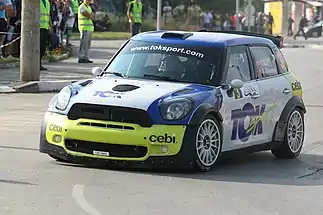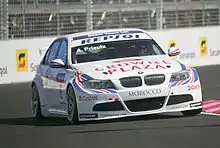Super 2000
Super 2000 is an FIA powertrain specification used in the World Rally Championship, the British Touring Car Championship, the World Touring Car Championship, and other touring car championships. The engines were originally 2 L naturally aspirated, and later being also allowed 1.6 L turbocharged units producing approximately 280 bhp.
| Super 2000 | |
|---|---|
| Motor racing formula | |
| Category | Touring cars Rally cars |
| Country or region | International |
| Championships | Various |
| Inaugural season | 2000 |
| Status | Active |

The goal of the Super 2000 classification is to allow more manufacturers and privateers to race by reducing the cost of a competitive car.
In order to cut costs and shorten development time, the Super 2000 rally cars originally used a common control gearbox and drivetrain made by a French company, Sadev. The FIA has since announced that Xtrac[1] and Ricardo Consulting Engineers will be allowed to also manufacture S2000 gearboxes to FIA specification. This is to further cut costs by introducing competition into gearbox supply.
These new rules allowed Ford to build from scratch their S2000 Fiesta vehicles in Australia, in as little as 14 weeks, starting out with a Super 1600 chassis and rollcage.
Specifications
Until 2011, FIA specifications for Super 2000 engines were as follows:[2][3]
- Derived from production model, of which at least 2500 have been produced in the past year
- Maximum of 2 litre (2000 cc) displacement
- 8500 rpm maximum
- All wheel drive is permitted in rally cars, but not in touring cars.
- 6-speed sequential gearbox (Control specification), or 5-speed MT gearbox retaining original gear ratios.
- Front and rear MacPherson suspension
- No electronic driver aids
In 2011 the specifications were revised, allowing 1600 cc turbocharged engines, and the use of 2000 cc normally-aspirated engines rapidly stopped as a result.[4] These engines fully replaced the 2 litre engines.
For the 2014 WTCC season, the TC1 regulations were introduced for touring cars. For the engine this included a larger air intake restrictor allowing power outputs of 380 bhp and more.[5]
For the 2017 WRC season, the engine intake restrictor diameter for rally cars was increased to 36 mm, allowing power output to rise to 380 bhp.[6]
Models
Rally cars

 Skoda Fabia S2000, in Monte-Carlo Rally driving by Nicolas Vouilloz
Skoda Fabia S2000, in Monte-Carlo Rally driving by Nicolas Vouilloz Fiat Grande Punto Abarth S2000, one of the most popular Super 2000 rally cars.
Fiat Grande Punto Abarth S2000, one of the most popular Super 2000 rally cars.

New regulations for the FIA World Rally Car were introduced in 2011. WRC cars would use the Super 2000 specification, and be powered by a 1600 cc turbo engine instead of the 2000 cc used previously. The WRC car would thus be based on the current 2011 model Super 2000 cars fitted with a supplementary kit for rallying.[7] The kit must be able to be fitted or removed within a defined time limit.[7][8]
Notes:
| A From 2012 the Regional Rally Car (commonly known as RRC) class was introduced. These cars became fitted with a 1.6 turbocharged engines similar to those used in the WRC cars, and with a smaller restrictor diameter of 30mm instead of 33mm. And with a body kit that also had to comply to the Super 2000 regulations.[9] |
Touring cars
 A Super 2000 BMW 320si competing in the 2009 World Touring Car Championship
A Super 2000 BMW 320si competing in the 2009 World Touring Car Championship A Super 2000 Honda Civic competing in the BTCC
A Super 2000 Honda Civic competing in the BTCC_(2).JPG.webp) Fabrizio Giovanardi driving a S2000 Vauxhall Vectra C for the VX Racing team in the British Touring Car Championship.
Fabrizio Giovanardi driving a S2000 Vauxhall Vectra C for the VX Racing team in the British Touring Car Championship..jpg.webp) S2000 Chevrolet Cruze's which won the Manufacturers' Championship in the 2010, 2011 and 2012 World Touring Car Championship season.
S2000 Chevrolet Cruze's which won the Manufacturers' Championship in the 2010, 2011 and 2012 World Touring Car Championship season. A S2000 SEAT Leon at the 2009 FIA WTCC Race of Morocco
A S2000 SEAT Leon at the 2009 FIA WTCC Race of Morocco.jpg.webp) A Citroën C-Elysée competing in the 2014 FIA World Touring Car Championship
A Citroën C-Elysée competing in the 2014 FIA World Touring Car Championship
The following cars were built under the TC1 (2014–2017) regulations:
- Chevrolet RML Cruze TC1
- Citroën C-Elysée
- Honda Civic WTCC
- Lada Granta WTCC
- Lada Vesta WTCC
- Volvo S60 Polestar TC1
The following cars were built under the TC2 Turbo (2011–2013) regulations:
Series
Super 2000 spec cars have run in:
Rally Competitions:
- World Rally Championship (as specification of World Rally Car)
- World Rally Championship-2 (formerly Super 2000 World Rally Championship or S-WRC)
- European Rally Championship (including the former Intercontinental Rally Challenge)
- Asia-Pacific Rally Championship
- Australian Rally Championship
- Italian Rally Championship
- Codasur South American Rally Championship
- South African Rally Championship
Touring Car competitions:
- World Touring Car Championship (2005-2014)
- European Touring Car Cup (2002-2017)
- ADAC Procar Series (2005-2014)
- Swedish Touring Car Championship (2003-2012)
- Dominican Touring Series
- Russian Touring Car Championship
- Asian Touring Car Series
South Africa was the first country in the world to run Super 2000 cars in rallying. Toyota South Africa and Volkswagen South Africa each built 2 cars to compete in the South African Rally Championship in 2005.
See also
- Diesel 2000, the related category for diesel powered touring cars
- Super 1600, a rally car formula that is primarily used in the Junior World Rally Championship
- Super 2000 World Rally Championship, a companion rally series to the World Rally Championship
References
- "Xtrac 532 S2000 gearbox press release" (PDF). Archived from the original (PDF) on 2011-07-18. Retrieved 2010-12-12.
- "FIA Appendix J Article 263 Specific Regulations for Modified Production Cars on Circuits (Super-2000)" (PDF). Archived from the original (PDF) on 2012-10-08. Retrieved 2010-12-12.
- "FIA Appendix J Article 254A Specific Regulations for Super 2000 – Rallies" (PDF). Archived from the original (PDF) on 2012-10-08. Retrieved 2010-12-12.
- "Touring Car Times - when is a touring car not a touring car". 2012-02-22. Retrieved 2017-01-26.
- "TouringCarTimes - Details on new 2014 sporting and technical regulations". 2013-07-02. Retrieved 2017-01-26.
- "FIA - dramatic new look for WRC cars". 2015-07-10. Retrieved 2017-01-26.
- http://www.crash.net/motorsport/wrc/news/161223-0/stay_of_execution_for_wrc_cars.html
- "maps out the future of the WRC". Wrc.com. Archived from the original on 2009-07-21. Retrieved 2010-12-12.
- "Archived copy". Archived from the original on 2012-11-14. Retrieved 2012-10-17.CS1 maint: archived copy as title (link)
| Wikimedia Commons has media related to Super 2000. |